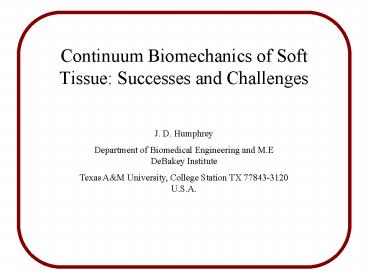Continuum Biomechanics of Soft Tissue: Successes and Challenges - PowerPoint PPT Presentation
1 / 40
Title:
Continuum Biomechanics of Soft Tissue: Successes and Challenges
Description:
Department of Biomedical Engineering ... and molecular approaches in modern medical science has led to an explosion ... Medical Dictionary (e.g., Dorland's) ... – PowerPoint PPT presentation
Number of Views:90
Avg rating:3.0/5.0
Title: Continuum Biomechanics of Soft Tissue: Successes and Challenges
1
Continuum Biomechanics of SoftTissue Successes
and Challenges
J. D. Humphrey Department of Biomedical
Engineering and M.E DeBakey Institute Texas AM
University, College Station TX 77843-3120 U.S.A.
2
Biomechanics - A Long History of Past Successes
Leonardo (1452-1519) Galileo (1564-1642) W.
Harvey (1578-1657) R. Descartes (1596-1650) G.
Borelli (1608-1679) L. Euler (1707-1783) and
many others
3
Biomechanics comes of age 1965
- Renaissance in continuum mechanics (1948-1965)
- Structural biology (1951, 1954)
- Digital computer (late 1950s - mid 1960s)
- Finite element methods (1956)
- Space race (1957-1969)
Note L. Pauling (1995) attributes the birth of
modern biology to the methods of theoretical
physics / mathematics
4
Constitutive Relations - The Key to Success
we see that the greatest need lies in the
direction of collecting data in multiaxial
loading conditions and formulating a theory for
the general rheological behavior of living
tissues when stresses and strains vary with time
in an arbitrary manner. Y.C. Fung (1973)
5
An Example - Vascular Mechanics
6
Early Stress Analyses (1979)
7
Importance of Residual Stress (1986)
8
Importance of Smooth Muscle (1999)
9
From Complexity Comes Simplicity
- Nonlinear Material Properties and Large Strain
- Anisotropy (circumferential muscle, axial
collagen) - Residual Stresses
- Smooth Muscle Activation
- Heterogeneity (functionally graded)
Question what optimization rules govern the
development and adaptation of vessels?
10
Future Challenges Promises
There are however innumerable other local
motions which on account of the minuteness of the
moving particles cannot be detected, such as the
motions of the particles in hot bodies,
fermenting bodies, in putrescent bodies, growing
bodies, in the organs of sensation and so forth.
If any one shall have the good fortune to
discover all these, I might almost say that he
will have laid bare the whole nature of bodies so
far as the mechanical causes of things are
concerned. Sir I. Newton (1642-1727)
11
Modeling in Mechanobiology
Cytokines
Cross-linking
Constitutive
Relations
Cell
Migration
Integrins
Mechanical
Loads
12
(No Transcript)
13
Developmental Biomechanics
Here and elsewhere we shall not obtain the best
insights into things until we actually see them
growing from the beginning Aristotle (384-322
B.C.)
without the aid of mechanicians, and others
skilled in simulation and modelling,
developmental biology will remain a prisoner of
our inadequate and conflicting physical
intuitions and methaphors. A.K Harris (1994)
See LA Taber (1995) Appl Mech Rev 48487-545.
14
(No Transcript)
15
Growth Remodeling
Growth - an increase in mass that is achieved
locally via an increase in the number
(hyperplasia, migration) or size (hypertrophy) of
cells and via a synthesis of extracellular matrix
that exceeds removal. Remodeling - a change in
structure that is achieved by reorganizing
existing constituents (cross-links) or by
producing new constituents having a different
organization.
16
Regulators of Vascular GR
17
Conceptually - GR
18
(No Transcript)
19
Constrained mixture stress-response
20
Stretches for a constrained mixture
21
Kinetics of production and removal
22
(No Transcript)
23
(No Transcript)
24
(No Transcript)
25
(No Transcript)
26
(No Transcript)
27
(No Transcript)
28
Solid-Fluid Coupling - Aneurysms
29
Linearization Stability in the Small
30
Elastodynamics of Aneurysms
31
Phase Plane Time Plot
32
(No Transcript)
33
Denaturation of Collagen
34
Thermomechanical Testing of Collagenous Membranes
35
Heat-induced Changes in Mechanical Properties
36
(No Transcript)
37
In Summary, the Need
The success of reductionist and molecular
approaches in modern medical science has led to
an explosion of information, but progress in
integrating information has lagged Mathematical
models provide a rational approach for
integrating this ocean of data, as well as
providing deep insight into biological
processes. 1998 BECON Report
38
The Promise...
- Molecular Cellular Biomechanics
- Developmental Biomechanics
- Growth Remodeling
- Injury Rehab
- Functional Tissue Engineering
- Muscle Mechanics
- Solid-Fluid Interactions
- Biothermomechanics
39
The Bioengineers Bookshelf
- Alberts et al. (2002) Molecular Biology of the
Cell. Garland Publishers. - Fawcett DW (1986) A Textbook of Histology. W.B.
Saunders. - Medical Dictionary (e.g., Dorlands)
- and a good system-specific text on physiology,
e.g., Milnor (1990) Cardiovascular Physiology,
Oxford.
40
Acknowledgments
Funding by the NIH, NSF, Texas-ATP, and Whitaker
Foundation
References
- Humphrey JD (2002) Cardiovascular Solid
Mechanics Cells, Tissues, and Organs,
Springer-Verlag, NY - Humphrey JD (2003) Continuum biomechanics of soft
biological tissues. Proc R Soc Lond A 459 3-46 - Humphrey JD (2003) Continuum thermomechanics and
the clinical treatment of disease and injury.
Appl Mech Rev 56 231-260. - Biomechanics and Modeling in Mechanobiology
http//link.springer.de































